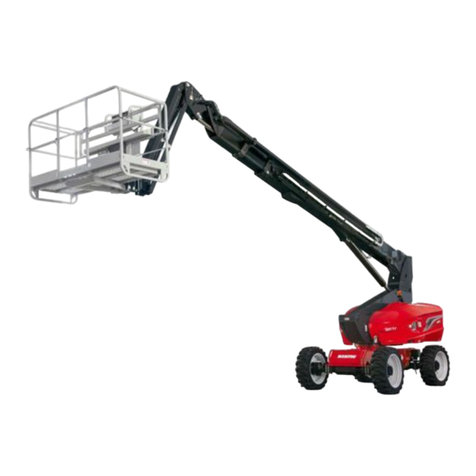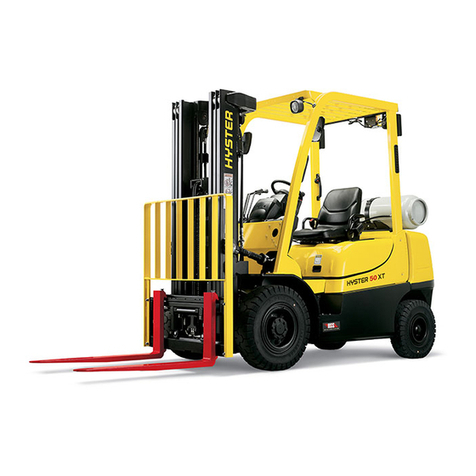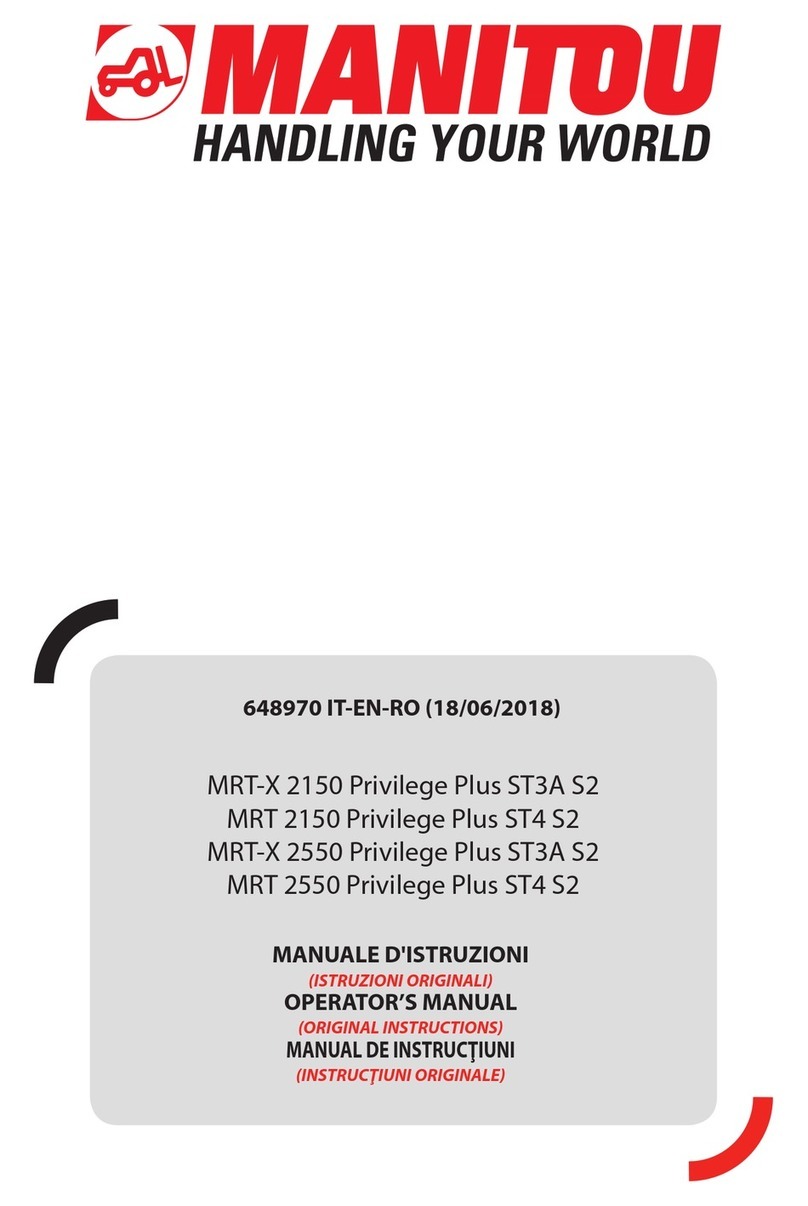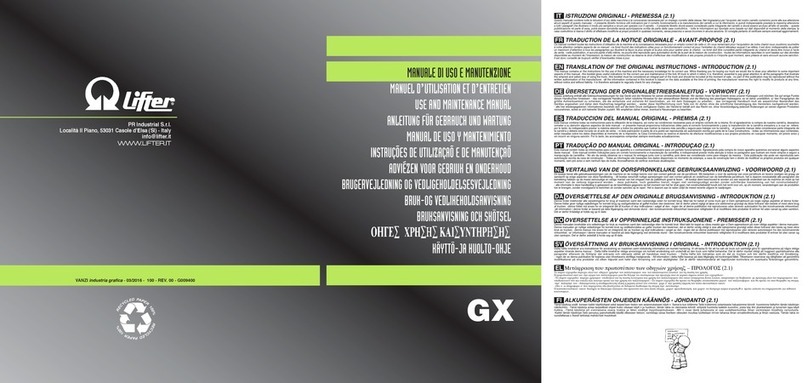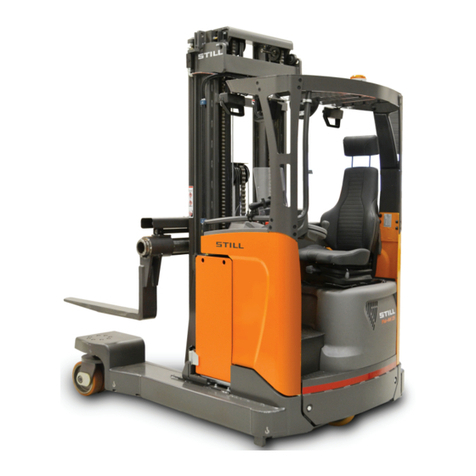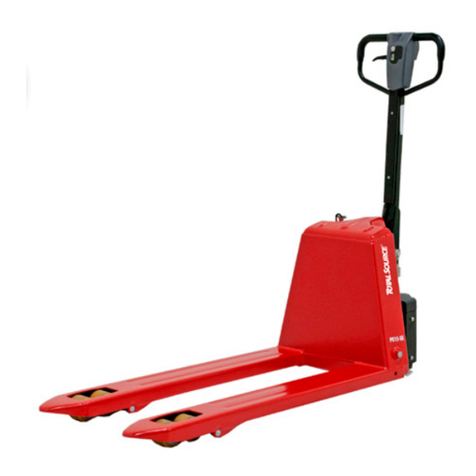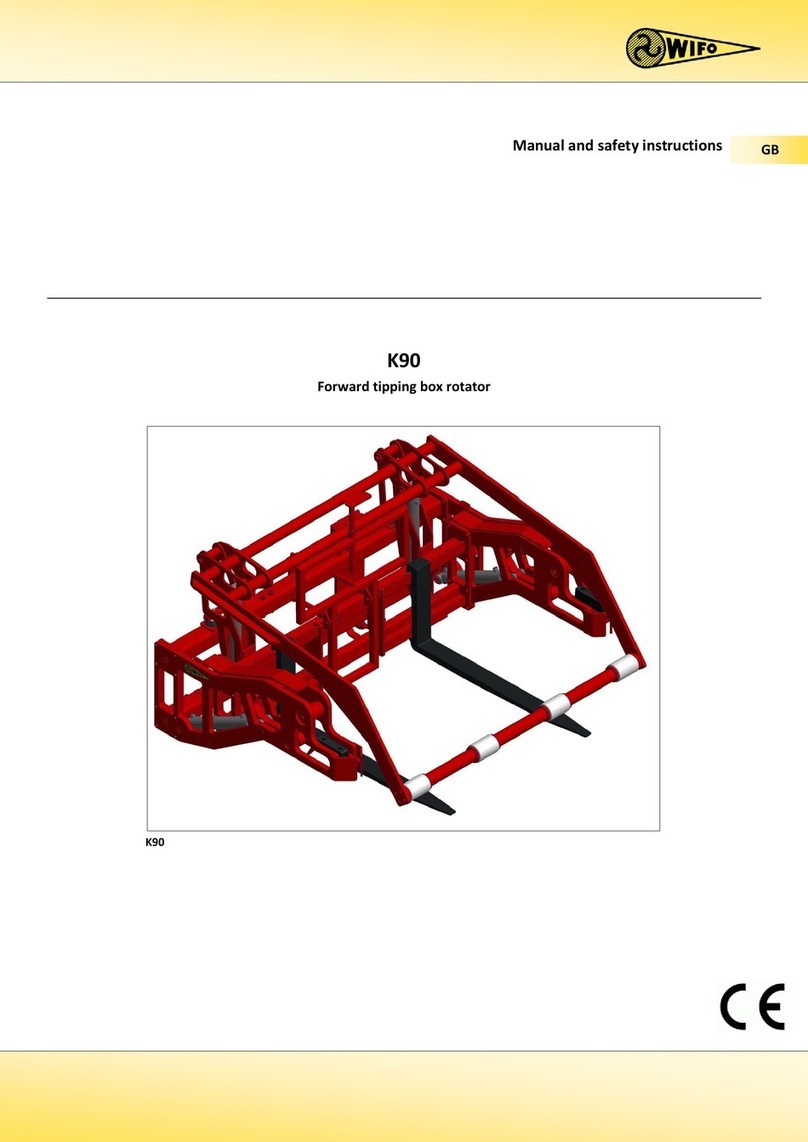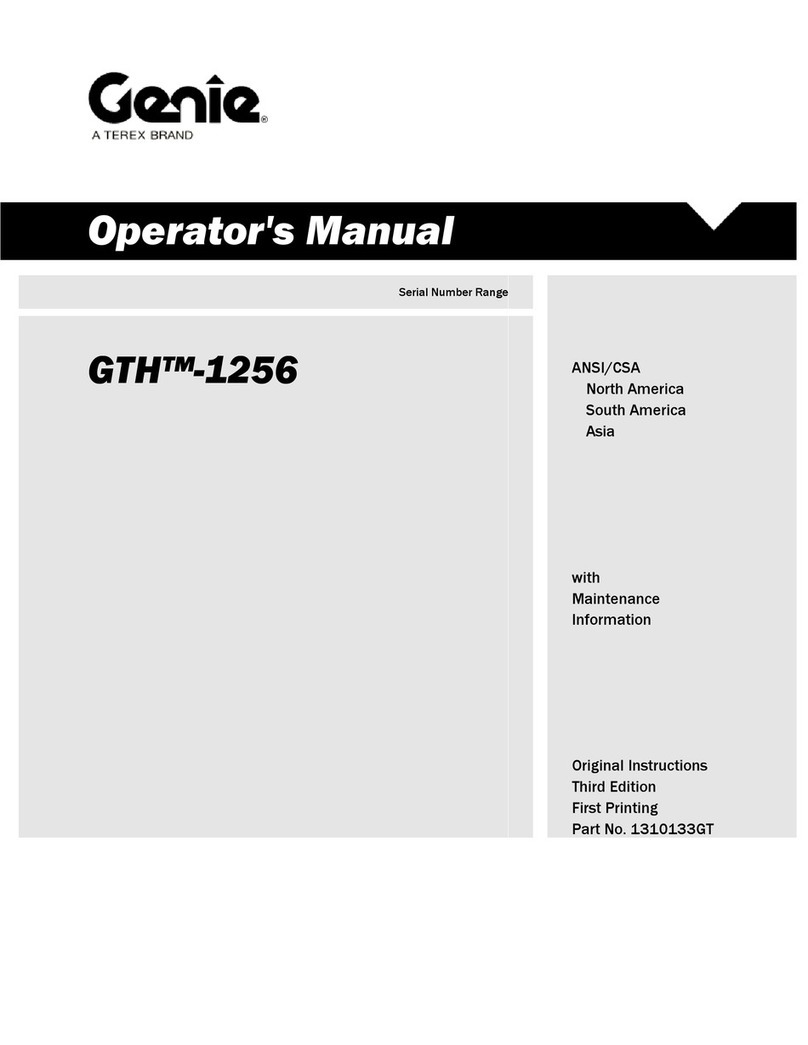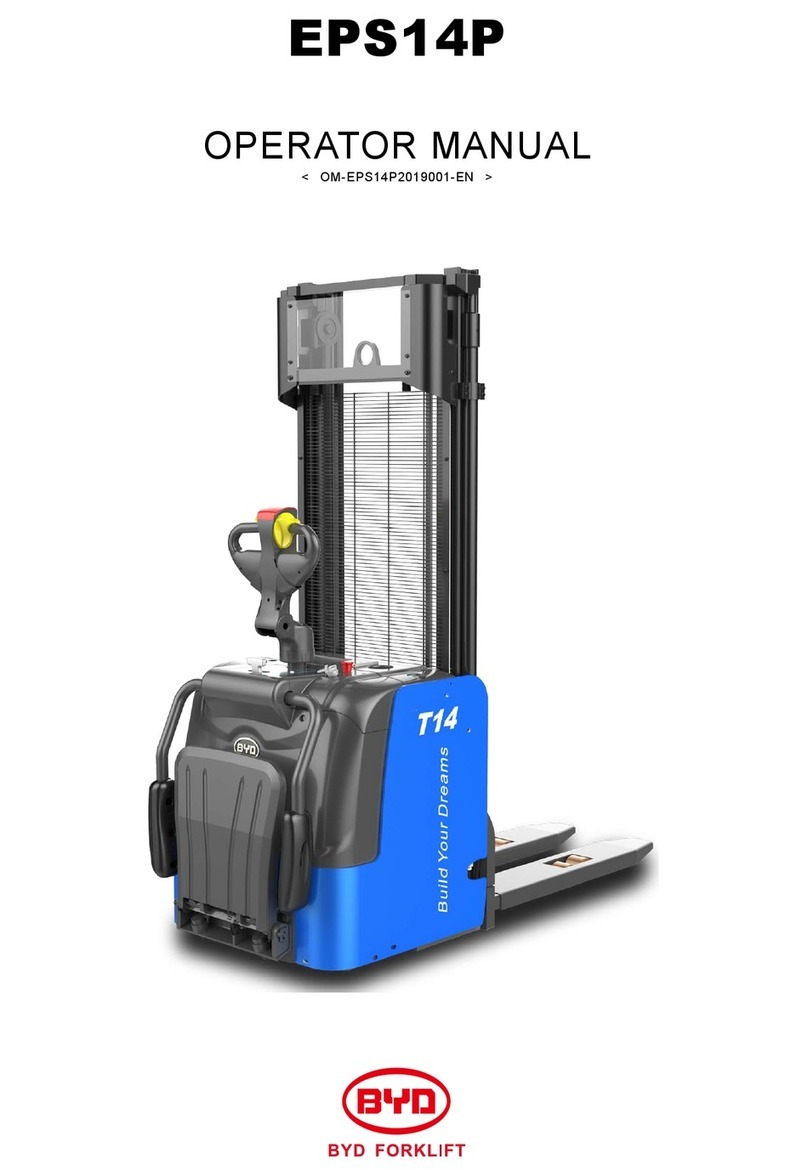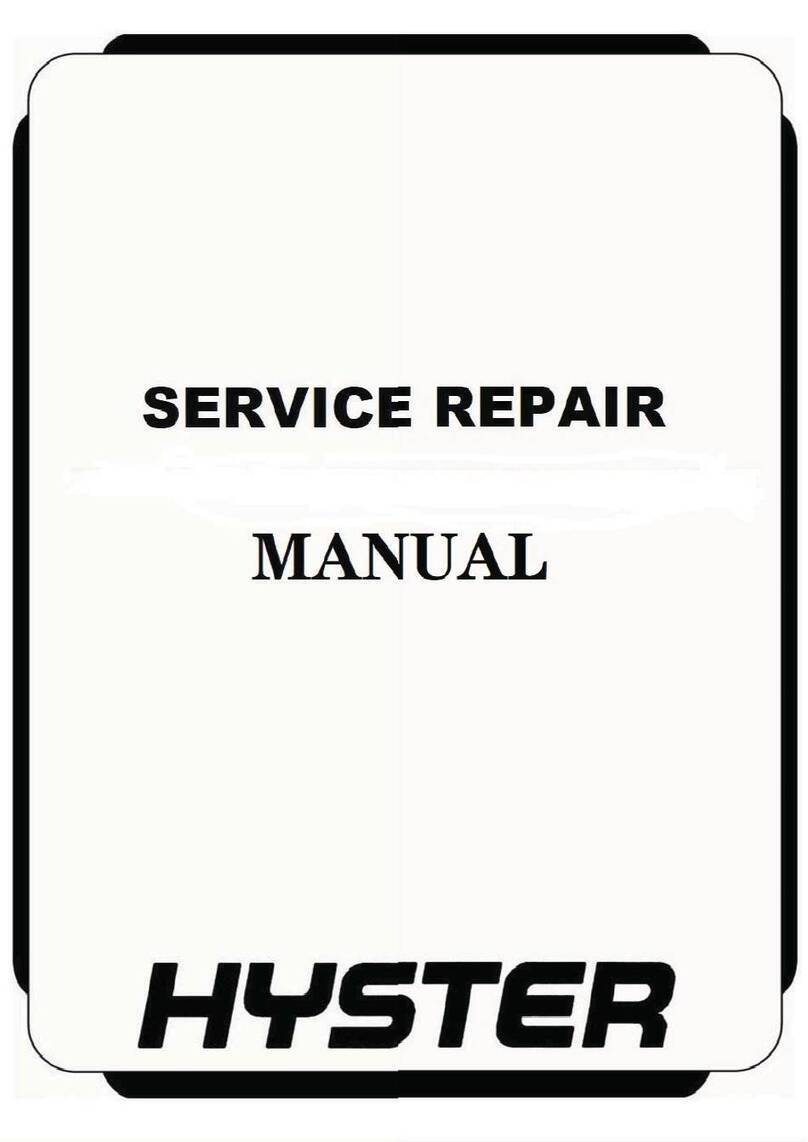Tarter PFQA User manual

PFQA PFQA12
TARTERUSA.COM
PALLET FORK
OPERATION AND ASSEMBLY MANUAL
For more information and questions, please contact:
Tarter Customer Service
1800REDGATE 18007334283
Monday-Friday 800430 EST
PFQA PFQA12

2
INTRODUCTION
THANK YOU.
Tarter Farm and Ranch Equipment has been improving life on your land since 1945. Thank you for choosing
Tarter. You have purchased a dependable Tarter implement. You can expect many years of service when you
maintain and use our implement according to this Manual and additional information that may be provided at
Tarterusa.com.
READ THIS MANUAL BEFORE ASSEMBLING OR OPERATING YOUR TARTER ATTACHMENT.
REQUIRE ALL OPERATORS TO READ THIS MANUAL.
OBSERVE ALL SAFETY INFORMATION IN THIS MANUAL AND SAFETY DECALS ON THE TARTER
ATTACHMENT.
If replacement parts are needed, use only genuine Tarter parts, as substitute parts will VOID THE WARRANTY
and may not meet standards required to insure dependable use and safe operation.
TARTERUSA.COM
For more information and questions, please contact:
Tarter Customer Service
1800REDGATE 18007334283
CUSTOMER INFORMATION
Name___________________________________________________
Purchased From___________________________________________
Date Purchased___________________________________________
Model___________________________________________________
Serial #_________________________________________________
PREPARATION CHECKLIST
Verify the following before operating your Pallet Fork
1. Inspect for damage or cracks before lifting.
2. Ensure forks slide/adjust freely.
3. Hook to skid steer or tractor and ensure fitment
is correct and locking pins fully engage bottom
holes.
4. Adjust forks to proper width to be centered under
any load
5. Never exceed posted load rating.

3
DESCRIPTION
GENERAL DESCRIPTION
If you are looking for a great all-around tool for your homestead, look no further than Tarter’s Pallet Fork. Simply attach
this implement to the front of your machine and start working. Great for moving pallets of feed, unloading equipment
from taller trailers, and other heavy lifting tasks - this implement will get the job done. Heavy-duty steel is laser cut
while robotic-assisted welders assemble the unit; providing unparalleled precision and accuracy. The forks are heavy-
duty and heat-treated for superior strength and durability. This do-it-all implement is the perfect companion to your
loader-equipped tractor. Observe all safety precautions on the machine and as noted throughout this manual. If any
assistance or additional information is needed, contact us at 1-800-RED-GATE.
NOTICE
All information, illustrations, and specifications in this manual are based on the latest information available at
the time of publication. Because we are always striving to improve our products, the images could differ slightly
from actual equipment. Specifications are subject to change without notice. We also reserve the right to make
changes at any time without notice.
PFQA PFQA12

4
TABLE OF CONTENTS
Description . . . . . . . . . . . . . . . . . . . . . . . . . . . . . . . . . . . . . . . . . . . . . . . . . . . . . . . . . . . . . . . . . . . . . . . . . . . . . . . . . . . . . . . . . . . . . . 3
Safety . . . . . . . . . . . . . . . . . . . . . . . . . . . . . . . . . . . . . . . . . . . . . . . . . . . . . . . . . . . . . . . . . . . . . . . . . . . . . . . . . . . . . . . . . . . . . . . . . . . 5
Safety Description and Decals . . . . . . . . . . . . . . . . . . . . . . . . . . . . . . . . . . . . . . . . . . . . . . . . . . . . . . . . . . . . . . . . . . . . . . . . . . . . . . 6
Operating . . . . . . . . . . . . . . . . . . . . . . . . . . . . . . . . . . . . . . . . . . . . . . . . . . . . . . . . . . . . . . . . . . . . . . . . . . . . . . . . . . . . . . . . . 11
Attaching . . . . . . . . . . . . . . . . . . . . . . . . . . . . . . . . . . . . . . . . . . . . . . . . . . . . . . . . . . . . . . . . . . . . . . . . . . . . . . . . . . . . . . . . . . . . . . . 13
Adjusting . . . . . . . . . . . . . . . . . . . . . . . . . . . . . . . . . . . . . . . . . . . . . . . . . . . . . . . . . . . . . . . . . . . . . . . . . . . . . . . . . . . . 14
Load Handling . . . . . . . . . . . . . . . . . . . . . . . . . . . . . . . . . . . . . . . . . . . . . . . . . . . . . . . . . . . . . . . . . . . . . . . . . . . . . . . . . 15
Detaching . . . . . . . . . . . . . . . . . . . . . . . . . . . . . . . . . . . . . . . . . . . . . . . . . . . . . . . . . . . . . . . . . . . . . . . . . . . . . . . . . . . . . . . . . 16
Lubrication/Maintenance . . . . . . . . . . . . . . . . . . . . . . . . . . . . . . . . . . . . . . . . . . . . . . . . . . . . . . . . . . . . . . . . . . . . . . . . . . . . . . . . . 17
Product Specifications . . . . . . . . . . . . . . . . . . . . . . . . . . . . . . . . . . . . . . . . . . . . . . . . . . . . . . . . . . . . . . . . . . . . . . . . . . . . . . . . . 18
Parts . . . . . . . . . . . . . . . . . . . . . . . . . . . . . . . . . . . . . . . . . . . . . . . . . . . . . . . . . . . . . . . . . . . . . . . . . . . . . . . . . . . . . . . . . . . . . . . . . . . . . . . 20
Torque Specifications . . . . . . . . . . . . . . . . . . . . . . . . . . . . . . . . . . . . . . . . . . . . . . . . . . . . . . . . . . . . . . . . . . . . . . . . . . . . . . . . . . . . . . 22
Trouble Shooting . . . . . . . . . . . . . . . . . . . . . . . . . . . . . . . . . . . . . . . . . . . . . . . . . . . . . . . . . . . . . . . . . . . . . . . . . . . . . . . . . . . . . . . . . . . 23
Warranty . . . . . . . . . . . . . . . . . . . . . . . . . . . . . . . . . . . . . . . . . . . . . . . . . . . . . . . . . . . . . . . . . . . . . . . . . . . . . . . . . . . . . . . . . . . . . . . 24
Notes . . . . . . . . . . . . . . . . . . . . . . . . . . . . . . . . . . . . . . . . . . . . . . . . . . . . . . . . . . . . . . . . . . . . . . . . . . . . . . . . . . . . . . . . . . . . . . . . . . . . . . 26
TABLE OF CONTENTS

5
THE BEST SAFETY DEVICE IS AN INFORMED, CAREFUL OPERATOR.
WE ASK YOU TO BE THAT KIND OF OPERATOR.
YOUR SAFETY is our concern. We design and manufacture our implements with this in mind. Our design can’t
eliminate an operator’s careless actions. Hazard control and accident prevention are dependent upon the awareness,
concern, judgment, and proper training of personnel involved in the operation, transport, maintenance and storage of
equipment.
CALIFORNIA PROPOSITION 65
WARNING: Cancer and reproductive harm - www.P65Warnings.ca.gov
Throughout this manual, the term IMPORTANT is used to indicate that failure to observe procedures can cause
damage to equipment. The terms CAUTION, WARNING and DANGER are used in conjunction with the Safety-Alert
Symbol, (a triangle with an exclamation mark), to indicate the degree of hazard for items of personal safety.
This Safety-Alert Symbol indicates a hazard and means ATTENTION!
BECOME ALERT! YOUR SAFETY IS INVOLVED!
Indicates an imminently hazardous situation that, if not avoided, will
result in death or serious injury.
Indicates a potentially hazardous situation that, if not avoided, could
result in death or serious injury, and includes hazards that are exposed when guards are
removed.
Indicates a potentially hazardous situation that, if not avoided, may
result in minor or moderate injury.
Indicates that failure to observe can cause damage to equipment.
Indicates helpful information.
SAFETY
WARNING
CAUTION
IMPORTANT
NOTE

6
SAFETY AND INSTRUCTIONAL DECALS
ATTENTION! BECOME ALERT! YOUR SAFETY IS INVOLVED!
Replace Immediately if Damaged!
SAFETY AND INSTRUCTION DECALS
PFQA PFQA12
1
2
43
4
1

7
SAFETY AND INSTRUCTIONAL DECALS
ATTENTION! BECOME ALERT! YOUR SAFETY IS INVOLVED!
Replace Immediately if Damaged!
SAFETY AND INSTRUCTION DECALS
Background Color: White □
Clear □
May 5, 2020
12.5 in
11.75 in
6 4000097_6 in x 1.75 in
ANSI SAFETY COLORS
X
Designer: MAP 7.75
Please proof carefully.
Electronically sign PDF and return for approval.
Gray lines indicate the die cuts.
Tarter USA
4000097-REV1
Please read and understand operation and assembly
manual before using this product. To obtain manual
please visit tarterusa.com or call 1-800-RED-GATE.
TO PREVENT SERIOUS INJURY OR DEATH
Please read and understand operation and assembly
manual before using this product. To obtain manual
please visit tarterusa.com or call 1-800-RED-GATE.
TO PREVENT SERIOUS INJURY OR DEATH
Please read and understand operation and assembly
manual before using this product. To obtain manual
please visit tarterusa.com or call 1-800-RED-GATE.
TO PREVENT SERIOUS INJURY OR DEATH
Please read and understand operation and assembly
manual before using this product. To obtain manual
please visit tarterusa.com or call 1-800-RED-GATE.
TO PREVENT SERIOUS INJURY OR DEATH
Please read and understand operation and assembly
manual before using this product. To obtain manual
please visit tarterusa.com or call 1-800-RED-GATE.
TO PREVENT SERIOUS INJURY OR DEATH
Please read and understand operation and assembly
manual before using this product. To obtain manual
please visit tarterusa.com or call 1-800-RED-GATE.
TO PREVENT SERIOUS INJURY OR DEATH
Background Color: White □
Clear □
July 19, 2019
12.5 in
11.75 in
2 4000070_5 in x 4 in
ANSI SAFETY COLORS
X
Designer: BR 4.5
Please proof carefully.
Electronically sign PDF and return for approval.
Gray lines indicate the die cuts.
TARTER
4000070
19 Inches
LOAD CENTER
KEEP OTHERS CLEAR.
3000 LBS MAXIMUM CAPACITY
KEEP LOAD
LEVEL.
-DO NOT EXCEED 3000 LBS. LIFTING CAPACITY AT 19” LOAD CENTER
-
DO NOT EXCEED THE RECOMMENDED LIFTING CAPACITY OF MACHINE
-
DO NOT USE FORK TINES FOR PRYING OR ANY OTHER PURPOSE OTHER THAN LIFTING
-ALWAYS KEEP LOAD LEVEL AND AT A SAFE LIFTING HEIGHT
-
DO NOT ALLOW PEDESTRIANS ON OR AROUND FORKS WHEN IN USE
DO NOT LIFT
ROUND BALES.
WARNING
4000070
19 Inches
LOAD CENTER
KEEP OTHERS CLEAR.
3000 LBS MAXIMUM CAPACITY
KEEP LOAD
LEVEL.
-DO NOT EXCEED 3000 LBS. LIFTING CAPACITY AT 19” LOAD CENTER
-
DO NOT EXCEED THE RECOMMENDED LIFTING CAPACITY OF MACHINE
-
DO NOT USE FORK TINES FOR PRYING OR ANY OTHER PURPOSE OTHER THAN LIFTING
-ALWAYS KEEP LOAD LEVEL AND AT A SAFE LIFTING HEIGHT
-
DO NOT ALLOW PEDESTRIANS ON OR AROUND FORKS WHEN IN USE
DO NOT LIFT
ROUND BALES.
WARNING
4000070
Jada Gaddis
7 00000 00000 0
0000000 A20 ABC
Background Color: White □
Clear □
June 23, 2021
12.5 in
11.75 in
2 4000363_5 in x 4 in
PRODUCT MATERIAL
8PW11
ANSI SAFETY COLORS
X
Designer: BR 4.5
Please proof carefully.
Electronically sign PDF and return for approval.
Gray lines indicate the die cuts.
TARTER
4000363
19 Inches
LOAD CENTER
KEEP OTHERS CLEAR.
1200 LBS MAXIMUM CAPACITY
KEEP LOAD
LEVEL.
-DO NOT EXCEED 1200 LBS. LIFTING CAPACITY AT 19” LOAD CENTER
-
DO NOT EXCEED THE RECOMMENDED LIFTING CAPACITY OF MACHINE
-
DO NOT USE FORK TINES FOR PRYING OR ANY OTHER PURPOSE OTHER THAN LIFTING
-ALWAYS KEEP LOAD LEVEL AND AT A SAFE LIFTING HEIGHT
-
DO NOT ALLOW PEDESTRIANS ON OR AROUND FORKS WHEN IN USE
DO NOT LIFT
ROUND BALES.
WARNING
4000363
19 Inches
LOAD CENTER
KEEP OTHERS CLEAR.
1200 LBS MAXIMUM CAPACITY
KEEP LOAD
LEVEL.
-DO NOT EXCEED 1200 LBS. LIFTING CAPACITY AT 19” LOAD CENTER
-
DO NOT EXCEED THE RECOMMENDED LIFTING CAPACITY OF MACHINE
-
DO NOT USE FORK TINES FOR PRYING OR ANY OTHER PURPOSE OTHER THAN LIFTING
-ALWAYS KEEP LOAD LEVEL AND AT A SAFE LIFTING HEIGHT
-
DO NOT ALLOW PEDESTRIANS ON OR AROUND FORKS WHEN IN USE
DO NOT LIFT
ROUND BALES.
WARNING
4000363
seth yaden
12
4
3

8
SAFETY
SAFETY GUIDELINES
At Tarter, we care about your safety. Most accidents
can be avoided by a few seconds of thought and a
careful approach to handling equipment. You, the
operator, can avoid many accidents by observing the
following precautions and insist those working with
you follow them too.
If you need assistance or a replacement manual and
safety decals, go to Tarterusa.com or call 1-800-RED-
GATE.
PLEASE READ YOUR TRACTOR/AUV/UTV (POWER
UNIT) MANUAL BEFORE ASSEMBLING OR
OPERATING YOUR TARTER ATTACHMENT.
In order to provide a better view, certain photographs
or illustrations in this manual may show an assembly
with a safety shield removed. However, a Tarter
attachment should never be operated in this condition.
Keep all shields in place. If shield removal becomes
necessary for repairs, replace the shield prior to use.
Replace any safety decal that is illegible or missing.
Location of such safety decals are indicated in this
manual.
Never use alcoholic beverages or drugs that can
hinder alertness or coordination while operating the
power unit or the Tarter attachment. Consult your
doctor about operating this machine while taking
prescription medications.
Under no circumstances should children under the
age of 18 be allowed to operate the power unit or the
Tarter attachment. Do not allow persons to operate
or assemble the Tarter attachment until they have
read this manual and have developed a thorough
understanding of the safety precautions and how it
works. Review the safety instructions with all users
annually.
This Tarter attachment can be dangerous to children
and persons unfamiliar with its operation. The
operator should be a responsible, properly trained and
physically able person familiar with farm machinery
and trained in this Tarter attachment’s operations.
Always use a power unit equipped with a Roll Over
Protective System and seat belts (ROPS). Keep your
seat belt securely fastened because falling off can
result in your death from being run over or crushed.
Always keep a foldable ROPS system in the “locked
up” position at all times.
Never exceed the limits of any piece of equipment,
whether the power unit of the Tarter attachment. If its
ability to perform a job safely is in question DO NOT
TRY IT.
Do not modify the Tarter attachment in any way.
Unauthorized modification could result in serious
injury or death and may impair the function and life of
the attachment.
In addition to the design of this attachment, including
safety signs and safety equipment, hazard control
and accident prevention are dependent upon the
awareness, concern, prudence, and proper training
of personnel involved in the operation, transport,
maintenance, and storage of the Tarter attachment.
Refer also to safety messages and operation
instruction in each of the appropriate sections of the
power unit and Tarter attachment manuals. Heed the
safety signs affixed to both the power unit and Tarter
attachment.
Follow all safety rules and safety decal information.
Your Tarter attachment is attached to a power unit.
You must know the controls of your power unit and
how to stop the engine and attachment quickly in an
emergency. All operators must be capable to safely
operate the power unit, its attachments, and all
controls.
PREPARATION
Always wear relatively tight and belted clothing to
avoid getting caught in any moving part. Wear sturdy,
rough-soled work shoes and protective equipment for
eyes, hair, hands, ears, and head. Wear respirator or
filter mask when appropriate.
DANGER: Failure to follow instructions or
safety rules can result in serious injury or
death.
DANGER: DO NOT allow anyone to operate
the power unit or the Tarter attachement
without proper instruction.

9
SAFETY
Check that all hardware is properly installed.
Always tighten to torque chart specifications unless
instructed otherwise in this manual.
Make sure the Tarter attachment is properly secured,
adjusted and in good operating condition.
A minimum of 20% of tractor weight must be on the
tractor’s front wheels when Tarter attachments are
in use. Without this weight, the tractor could tip over,
causing personal injury or death. The weight may be
attained with a loader, front wheel weights, ballast in
tires or front tractor weights. Weigh the tractor and
Tarter implement. DO NOT ESTIMATE.
STARTING AND STOPPING
Understand how to stop the Power Unit and Tarter
attachment quickly in case of an emergency.
Before starting, check over all pins, bolts, and
connections to be sure all are securely in place. Make
sure power unit is in neutral
Start the power unit from the driver’s seat.
Always lower Tarter attachment to the ground and
relieve hydraulic pressure. Park on level ground, shut
off the power unit, put the power unit or park or set the
parking brake, and remove the key when leaving the
equipment.
TRANSPORTATION
Never transport the power unit or the Tarter
attachment while under the influence of alcohol or
drugs.
Always comply with all federal, state and local laws
regarding lighting, marking requirements and
transportation of farm equipment on a public roadway.
Never allow riders on the power unit or Tarter
attachment.
Maximum transport speed for an attached equipment
is 20 mph. DO NOT EXCEED. Never travel at a speed
which does not allow adequate control of steering and
stopping.
Transport only in daylight or satisfactory artificial light.
Always transport loads low to the ground to maintain
stability of the power unit.
Be aware of overhead utility lines.
Avoid contact with any overhead utility lines or
electrically charged conductors.
Watch for hidden hazards on the terrain during
transport.
Do not operate or transport on steep slopes.
Do not stop, start, or change directions suddenly on
slopes.
Use extreme care and reduce ground speed on
slopes and rough terrain. When encountering rough
terrain during transport, reduce the power unit speed
to minimize the horizontal movement of the Tarter
attachment.
Ensure the towing vehicle and trailer are safely
capable of transporting the Tarter attachment and that
everything is properly secured.
OPERATION
Be sure the power unit is properly counterbalanced
with weights before attempting to lift any load.
Never operate the power unit or the Tarter attachment
while under the influence of alcohol or drugs.
Make sure the Tarter attachment is securely mounted
to the loader. Failure to install lock pins or have the
locking mechanism engaged, could result in injury or
death.
Always know the weight of the load being lifted.
Maximum lift capacity should never exceed rated lift
capacity of the Tarter attachment. It should never
exceed 80% of the power unit rated lift capacity for an
attached front loader. Use the smaller of the two lift
capacities to determine maximum lift capacity.
Lightweight power units may need weight added to
the rear to maintain control and prevent forward or
side tipping caused by a heavy front load. Consult your
power unit Operator’s Manual to determine proper
weight requirements and maximum weight limitations.
Operate only in daylight or satisfactory artificial light.
Do not allow bystanders in the area when operating,
attaching, removing, assembling, or servicing the
power unit or Tarter attachment. Never allow anyone to

10
SAFETY
walk or work under a raised loader.
Do not lift or carry anyone on the attachment. Do not
use the attachment as a work platform.
This Tarter attachment is intended for agricultural
applications only. Do not operate within 300 feet of
bystanders or public roads or highways.
Keep hands, feet, hair and clothing away from the
power unit and Tarter attachment while the power unit
engine is running. Stay clear of all moving parts.
Always sit in the power unit seat when operating
controls or starting engine. Securely fasten seat
belt, place transmission in neutral, engage brake
and ensure all other controls are disengaged before
starting the power unit engine.
Look down and to the rear and make sure area is clear
before operating in reverse.
Watch for hidden hazards on the terrain during
operation.
Do not operate on steep slopes.
Do not stop, start, or change directions suddenly on
slopes.
When handling material on a slope, always approach
the material with the power unit facing uphill.
Use extreme care and reduce ground speed on slopes
and rough terrain. When encountering rough terrain,
reduce the power unit speed to minimize the horizontal
movement of the Tarter attachment.
Do not use this Tarter attachment to lift the front or
back of the power unit off the ground. Doing so can
damage the Tarter attachment, power unit and cause
serious injury or death.
Stop the power unit and equipment immediately
upon striking an obstruction. Turn off engine, remove
key, inspect, and repair any damage before resuming
operation.
MAINTENANCE
Make certain all movement of the power unit and
Tarter attachment components has stopped before
approaching for service.
Before detaching the power unit from the
Tarter attachment or performing any service or
maintenance, follow these steps: disengage power to
the power unit, lower the front-end loader/attachment
to the ground, set parking brake, stop engine, remove
key, and unfasten seat belt.
Always secure attachment with solid supports. Do
not use concrete blocks, logs, buckets, or any other
material that could collapse or shift positions.
Before working underneath the power unit or a Tarter
attachment, carefully read this manual’s instructions,
raise attachment, securely support all corners, and
check stability. Secure blocking prevents a Tarter
attachment from dropping due to hydraulic leak down,
hydraulic system failures or mechanical component
failures. Never depend on hydraulic system to keep
attachment in raised position.
Never go underneath a Tarter attachment (lowered to
the ground or raised) unless it is properly supported
and secured. Never place any part of the body
underneath the power unit or a Tarter attachment
or between moveable parts even when the engine
has been turned off. Hydraulic system leak down,
hydraulic system failures, mechanical failures, or
movement of control levers can cause a Tarter
attachment to drop or rotate unexpectedly and cause
severe injury or death. Follow the power unit and
Tarter attachment manual for working underneath
and blocking procedures.
Always wear relatively tight and belted clothing to
avoid getting caught in moving parts. Wear sturdy,
rough-soled work shoes and protective equipment for
eyes, hair, hands, ears, and head. When appropriate
wear a respirator or filter mask.
Keep all persons away from you while performing
adjustments, service or maintenance.
Frequently check for loose hardware, missing parts,
broken parts, structural cracks, and excessive wear.

11
SAFETY
Make repairs before putting the implement back into
service. Careless or improper handling may result in
serious injury.
After briefly using your attachment check forks
to make sure they are still secured and check
attachment to make sure it is still properly attached to
the loader.
Always remove any material that has become
entangled in the attachment before continuing to use
them.
Do not modify, alter, or permit anyone else to modify
or alter the power unit, the Tarter attachment or any of
their components in any way, except as outlined in this
Manual.
STORAGE
Always use a power unit to position a Tarter
attachment for storage.
Remove any debris or dirt that may have accumulated
on the Tarter attachment.
Inspect the pallet fork for damaged or worn parts and
replace when needed.
Store the Tarter attachment away from human
activity and livestock. Damage and injury to human or
livestock could result.
Block the Tarter attachment securely for storage.
Keep children and bystanders away from storage area.
WARNING: Never attempt to move Tarter
attachment by hand.

12
OPERATING
OPERATING
Before each use, perform all necessary maintenance
described in the maintenance section.
Read, understand, and follow the safety information
pertaining to training, preparation, starting and stopping,
operation, transportation, maintenance, and storage at
the beginning of this manual.
Maximum lift capacity should never exceed rated lift
capacity of the pallet fork.
Keep the load slightly tilted back to secure its weight
against the frame. The heaviest side should be closest to
the frame and not near the end of the fork tines.
Rotating the front of forks too high can cause the load
to shift and fall onto the operator or others. Rotating the
front of the forks level or lower can cause the load to fall
forward.
Make sure pallet fork frame is properly attached to loader.
Completely engage the load before lifting. Fork length
should be at least two-thirds of the load length. It is
recommended to always keep the lifting surface of the
forks level. When backward tilt is required to stabilize the
load, use extreme caution.
Keep the load centered on attachment and loader.
Unbalanced loads increase the possibility of tipping or
rolling over. Secure the load properly. Unsecured loads
can fall unexpectedly.
Make sure the weight of the load is centered between the
forks.
Lift the load slightly to make sure the load is stable. If the
load appears to be unstable, lower and reposition.
NEVER lift a load with one fork. This will cause the load to
be unbalanced.
NEVER lift objects without pallets.
Do not lift round bales.
Check the pallet fork frequently to make sure it is properly
attached. Also check and make sure the pins are seated
and locked in place as well as the forks are secured to
upper carrying bars.
Do not use forks for digging, pushing, prying, pulling or
lifting. Only lift palletized loads.
Do not chain or strap palletized loads to loader arms,
loader hitch, pallet form frame or forks.
Always lower forks to the ground before dismounting
from the power unit.
DANGER: Capacity based on balanced load
placed no more than halfway out from head
unit. Do not exceed the capacity of your
front-end loader attachment or tractor.
WARNING: For PFQA - Do not exceed 3000
lbs. lifting capacity at 19” load center.
For PFQA12 – Do not exceed 1200 lbs. lifting
capacity at 19” load center.

13
5. Push the locking pins on the loader down, until the
locking pins fully extend through the bottom slots of
the pallet fork.
MAKE SURE LOCKING HANDLES ARE IN THE
LOCKED POSITION.
ATTACHING
ATTACHING TO TRACTOR
1. Make sure the locking pins, on the loader, are fully
raised.
2. Drive forward and adjust the loader height and
position. Tilt the loader slightly forward and place the
top of the loader hitch under the top of the angle bars
on the pallet fork.
3. Slowly lift the loader until the loader and the pallet fork
have come together.
4. Slowly tilt the loader to align the bottom slots, on the
pallet fork, with the locking pins on the loader.

14
ADJUSTING
1. Make sure tractor and pallet forks are on level
ground, tractor is in park or parking brake is set
and tractor is turned off before dismounting.
2. Make sure the locking pin on the fork is in the
unlocked position.
3. Slide the fork along the upper carrying bar by
pushing or pulling until desired location.
4. Position the locking pin over desired notch and
secure.
5. Repeat these steps for second fork.
ADJUSTING
CAUTION: Be sure to check the locking
pin and make sure it is secure and fork is
attached.
CAUTION: Please wear gloves when
installing and adjusting forks. Possible
pinch points.
CAUTION: Be sure to check the locking
pin and make sure it is secure and fork is
attached.

15
LOAD HANDLING
PICKING UP A LOAD
1. Center the forks under the pallet to evenly distribute
the weight and make sure the load is balanced and
secure.
2. Drive into the load as far as possible and then lift the
load off the ground and tilt back slightly.
3. Position the load at a safe traveling height before
moving. (Two to four inches above the ground is
recommended for traveling)
TRAVELING WITH A LOAD
With the load tilted back and two to four inches above the
ground, always drive at a safe speed and slow down when
going around corners. Avoid sudden braking.
Only raise or lower the load when completely stopped,
never while traveling.
PLACING A LOAD
1. Stop in front of desired location.
2. Carefully and slowly raise or lower the load to the
desired height.
3. Slowly move forward until the load is square and
positioned straight above desired location.
4. Make sure load is level for placement and lower the
load to desired location.
5. Once the load is settled back up slowly.
NOTE: Leave enough clearance when
turning to keep pallet forks and the load
from contacting obstacles.
NOTE: Make sure forks are clear of the pallet
before turning or adjusting the height of the
forks.
NOTE: When possible, travel straight up and
down grades, ramps, and inclines. Avoid
making sharp turns and slow down. When
traveling over a ramp or incline, keep the
load on the uphill side of the power unit.
Slow down while traveling over rough or hilly
terrain.

16
DETACHING
DETACHING
1. Make sure tractor and pallet forks are on level ground,
tractor is in park or parking brake is set and tractor is
turned off before dismounting.
2. Pull the locking handles up to remove the pins from
the bottom slots of the pallet fork.
3. Return to the tractor and start the tractor. Tilt the top
of the loader slightly forward and slowly lower the
pallet fork until the top angle bars and the loader have
separated.
4. Slowly back the tractor away from the pallet forks.
Make sure the loader does not interfere with the pallet
fork.

17
LUBRICATION/MAINTENANCE
1. Check forks to make sure they are not damaged,
broken or worn excessively. Repair or replace as
needed.
2. Replace any work, damaged, or illegible safety labels
by obtaining new labels from your local Tarter dealer.

18
PRODUCT SPECIFICATIONS
PQFA
PQFA
Hitch Universal Quick-Attach
Lifting Capacity *3000 lbs.
Weight 368 lbs.
Overall Width 45.5"
Overall Length 48"
Height 34.5"
Fork Length 42"
Fork Cross Section 1.25"x4" ITA heat treated

19
PRODUCT SPECIFICATIONS
PQFA12
PQFA12
Hitch Universal Quick-Attach
Lifting Capacity *1200 lbs.
Weight 238 lbs.
Overall Width 46"
Overall Length 49"
Height 34"
Fork Length 42"
Fork Cross Section 1"x3" ITA heat treated

20
PARTS
PQFA
Item # Part# Description
1 4000077 Tarter Standard Decal (each)
2 9000157 Replacement Pallet Forks (pair)
3 4000070 3000 lb pallet fork warning decal
This manual suits for next models
1
Table of contents
